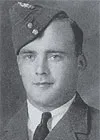Simmons, Robert Louis Nathaniel (Sergeant)
Killed in Action 1942-01-06


Birth Date: unkown date
Born:
Home:
Enlistment:
Enlistment Date: Unknown
Service
RAFVR
Unit
57 (B) Sqn- Squadron (RAF)
Corpus Non Animum Muto I change my body, not my spirit
Base
Feltwell
Rank
Sergeant
Position
Sergeant
Service Numbers
1378726
Target
 Brest
Brest
Wellington IC Z1096
Bombing Brest France 1942-January-06 to 1942-January-06
(B) Sqn (RAF) Feltwell
31 Wellingtons of I Group attacked the German warships, Scharnhorst and Gneisenau. I aircraft lost. No special bombing results were claimed but a bomb which fell alongside the Gneisenau holed the hull and flooded 2 compartments.source: The Bomber Command War Diaries, Martin Middlebrook and Chris Everitt
57 Squadron (Corpus Non Animum Muto). Wellington aircraft Z 1096 took off 0520 6 Jan 1942 from Feltwell and crashed 0530 into Home Field at Holmebrink Farm at nearby Methwold. a fire broke out on impact and the Wellington was destroyed.
Flight Sergeant D R Richardson (RCAF), Sergeant R L Simmons,(RAF) Sergeant E Ewings,(RAF) Sergeant L J Roe,(RAF Sergeant V H Mountstephens:(RAF killed; Pilot Officer S H Carter (RAF): injured.
Wellington Z1096
Vickers Wellington

Vickers Wellington B. Mk. III (Serial No. X3763), coded KW-E, No. 425 'Alouette' (B) Squadron, RCAF, late summer of 1942
The Vickers Wellington was a British twin-engined, long-range medium bomber. It was designed during the mid-1930s at Brooklands in Weybridge, Surrey. Led by Vickers-Armstrongs' chief designer Rex Pierson, a key feature of the aircraft is its geodetic airframe fuselage structure, which was principally designed by Barnes Wallis. Development had been started in response to Air Ministry Specification B.9/32, issued in the middle of 1932, for a bomber for the Royal Air Force. This specification called for a twin-engined day bomber capable of delivering higher performance than any previous design.
The Wellington was used as a night bomber in the early years of the Second World War, performing as one of the principal bombers used by Bomber Command. During 1943, it started to be superseded as a bomber by the larger four-engined "heavies" such as the Avro Lancaster. The Wellington continued to serve throughout the war in other duties, particularly as an anti-submarine aircraft.
It holds the distinction of having been the only British bomber that was produced for the duration of the war, and of having been produced in a greater quantity than any other British-built bomber. The Wellington remained as first-line equipment when the war ended, although it had been increasingly relegated to secondary roles. The Wellington was one of two bombers named after Arthur Wellesley, 1st Duke of Wellington, the other being the Vickers Wellesley.
In August 1936, an initial order for 180 Wellington Mk I aircraft, powered by a pair of 1,050 hp (780 kW) Bristol Pegasus radial engines, was received by Vickers; it had been placed so rapidly that the order occurred prior to the first meeting intended to decide the details of the production aircraft. In October 1937, another order for a further 100 Wellington Mk Is, produced by the Gloster Aircraft Company, was issued; it was followed by an order for 100 Wellington Mk II aircraft with Rolls-Royce Merlin X V12 engines. Yet another order was placed for 64 Wellingtons produced by Armstrong Whitworth Aircraft. With this flurry of order and production having been assured by the end of 1937, Vickers set about simplifying the manufacturing process of the aircraft and announced a target of building one Wellington per day.
A total of 180 Wellington Mk I aircraft were built; 150 for the RAF and 30 for the Royal New Zealand Air Force (RNZAF) (which were transferred to the RAF on the outbreak of war and used by 75 Squadron). In October 1938, the Mk I entered service with 9 Squadron. The Wellington was initially outnumbered by the Handley Page Hampden (also ordered by the Ministry to B.9/32) and the Armstrong Whitworth Whitley (to B.34/3 for a 'night' bomber) but outlasted both rival aircraft in service. The Wellington went on to be built in 16 separate variants, in addition to two training conversions after the war. The number of Wellingtons built totalled 11,462 of all versions, a greater quantity produced than any other British bomber. On 13 October 1945, the last Wellington to be produced rolled out.Wikipedia
 Library and Archives Canada Service Files (may not exist)
Library and Archives Canada Service Files (may not exist)

 Wikipedia Vickers Wellington
Wikipedia Vickers Wellington RCAF - Vickers Wellington
RCAF - Vickers Wellington YouTube Vickers Wellington documentary
YouTube Vickers Wellington documentary